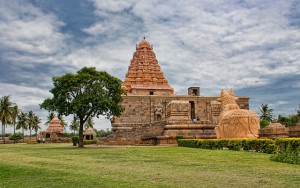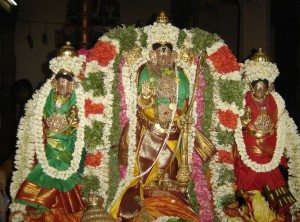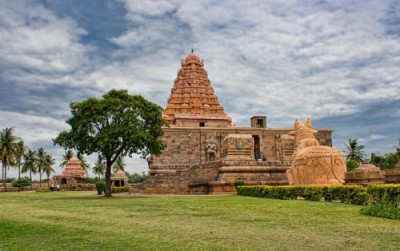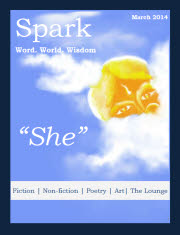by Preeti Madhusudhan
December in Tamilnadu is akin to a rare flower, the kind that deserves an organized show with expensive tickets, VIP stalls and effusive odes sung to its glory. The temperature is a balmy, mild 26 degree Celsius on an average, with night temperatures dropping to a surprisingly pleasant 20-21 degree celcius. Humidity is low or non-existent. The weather puts the auto-wallahs and roadside vendors in Chennai at their genial best, so you find you don’t have to haggle much. Taking advantage of the weather, the sabhas put up their annual music festivals. Out, come the gorgeous silk saris and lovely jewelry that accompanies them. Music literally fills the soothing air of Tamilnadu, as radio and TV channels vie each other to telecast these concerts through the month.
But December is also the month of devotion. The lord himself declares in the Bhagavad Gita(10.35) “Maasaanaam Maargasheershoham” – “Of the months, I am Maargasheersha”, i.e Margazhi the month, which equals the western calendar dates between the 15th of December-the 15th of January. Our preceptors have set aside a month in a year for us to devotionally engage ourselves. Today, this is more poignant perhaps than ever. Thirty days of the three hundred and sixty five, to retract inward, recluse and quietly observe the Self, re-position its coordinates with respect to the larger scheme of things. Special Utsavs are held in temples to honor the saivite and vaishnavite poets – namely the Nayanmars and Alvars, and religious lecturers dissert their hymns and poems for the benefit of the streams of bhaktas.
Most prominent amongst these poets is the lady poet, Andal. Of the hundred and seventy three hymns she sang, a collection of thirty called the “tiruppavai” are especially important in Margazhi, a hymn for each day of the month. Thirty hymns through which she undertakes a “nombu”, a passive-penance, an oath of steadfastness, thirty hymns in delightful Tamil, through which she awakens the maiden of each house in her neighborhood, to accompany her to see Krishna, the lord of every gopika’s heart. What appears at the first glance as elegant verses sung by a lovelorn maiden delirious with bhakti, are actually interlaced with layers upon layers of hidden ideology, concepts from the Vedas defining the Supreme, the Self all sugarcoated with phrases of love and simple devotion. So, December is in fact the ancient Tamil version of Valentine’s day, only more elaborate and elongated. But such is the elegance of the phrases, veracity of the message and dazzling imagery of the poet, that the Tamil Margazhi, the Alvars and Nayanmars are unrivalled in the art of esoteric love.
From this background of devotional love, there emerges a warrior, a poet, a vaishnavite, distinct in his bearing and profession. The warrior poet Kaliyan, known as Tirumangayazhwar, was a tribal chieftain who was swayed into vaishnavism owing to his love for Kumudavalli. Kumudavalli, a vaishnavite, made Kaliyan promise to feed a 1008 Vaishnavas every day for a year. In order to win her affection, Kaliyan began this endeavor, only to resort to highway-robbery to make ends meet. In an effort to rob a party of newly-weds, he bites the toe of the groom, aiming to remove his toe-ring. Lo! He has bitten the toe of the Lord, come to test him and impart knowledge to him.
This is what makes one catch one’s breath. A tribal king-turned-highway robber-turned-devout poet. One can read shades of regal arrogance in his words as he declaims the Jains, saivites and Buddhists. One can hear abject dismay as he beseeches the lover (the lord) to consider his (Thirumangai Alvar) daughter as His partner.
“She, the young damsel of moon-like countenance
Born with Amrit off the milk-ocean
That she resides in your chest, is known and
Yet (my daughter) has not renounced desire for you
Endowed with kuvalai – flower eyes, like the statue of Kolli hills
Pray tell, with desire only for your lotus-feet
Of this girl, what is your intention
O lord of Tiruvidavendai!”
 December is the month when schools in Australia close down for their annual holidays, as the southern hemisphere starts heating up. The timing couldn’t be more perfect, and so my son and I pack our bags in the trail of Kaliyan, a king, a lover, a highway-robber and finally an Alvar (one who is immersed in his love for the lord). Our aim is to make Kumbakonam, a six hour drive from Chennai, our base-camp, and visit the many temples that are known for their associations with Kaliyan and the other Alvars. Kumbakonam and its surrounding towns and villages house a multitude of temples dedicated both to Shiva and Vishnu. As the urban ugliness of Chennai flies past the car windows, the more rural, rustic beauty of Tamilnadu starts to emerge, dotted by clumps of villages, towns and cities of distinction. Just ahead of Kumbakonam, we decide to take a detour to Gangaikondachozhapuram, which preconditions our minds for what is to come. Once the capital of southern India for a brief yet important time in the history of the region, it is now a forgotten village off the highways, centered on a ruined temple complex. Yet, the sheer scale of the sculptures inside prepares you for what lies ahead. What lies ahead is what sparked the imagination of the Alvars millennia earlier. A heightened sense of aesthetics in stones and words alike molded the Bhakti movement here. My son is now all eager to continue gawking at “big temples”. “Yippee!” he yells as he hurriedly scrambles out of the car. The fact that whatever he was going to see was at least a few hundred years old fires his enthusiasm. “No one is going to believe me in school,” he says.
December is the month when schools in Australia close down for their annual holidays, as the southern hemisphere starts heating up. The timing couldn’t be more perfect, and so my son and I pack our bags in the trail of Kaliyan, a king, a lover, a highway-robber and finally an Alvar (one who is immersed in his love for the lord). Our aim is to make Kumbakonam, a six hour drive from Chennai, our base-camp, and visit the many temples that are known for their associations with Kaliyan and the other Alvars. Kumbakonam and its surrounding towns and villages house a multitude of temples dedicated both to Shiva and Vishnu. As the urban ugliness of Chennai flies past the car windows, the more rural, rustic beauty of Tamilnadu starts to emerge, dotted by clumps of villages, towns and cities of distinction. Just ahead of Kumbakonam, we decide to take a detour to Gangaikondachozhapuram, which preconditions our minds for what is to come. Once the capital of southern India for a brief yet important time in the history of the region, it is now a forgotten village off the highways, centered on a ruined temple complex. Yet, the sheer scale of the sculptures inside prepares you for what lies ahead. What lies ahead is what sparked the imagination of the Alvars millennia earlier. A heightened sense of aesthetics in stones and words alike molded the Bhakti movement here. My son is now all eager to continue gawking at “big temples”. “Yippee!” he yells as he hurriedly scrambles out of the car. The fact that whatever he was going to see was at least a few hundred years old fires his enthusiasm. “No one is going to believe me in school,” he says.
We reach Kumbakonam around mid-noon, and go to our accommodation near Opiliyappan temple in the town Vinnagar, praised by Tirumangaiazhvar as “Poomaru Pozhilani Vinnagar” – Vinnagar of dense gardens and fragrant flowers. Jacaranda trees bearing red and orange blossoms and bright orange flowers from pumpkin creepers peep from everywhere. We mull on the words of Alvar on this lord “Kaadhal Seidhu Ilayavar Kalavitharum Vedanai Vinayadhu Veruvuthalaam”, as our car leaves to a place 20kms from here. “The pleasure that young women yield is the entirety of sorrows, which leads to perpetual material afflictions” he laments! The poet is now in the throes of love for the Lord and begs again and again for release from a materialistic life. Where is the lover we are in search of?
Tiruveliyangudi, our first stop, is supposed to have existed through all the four yugas, or eras – Satya, Treta, Dvapara and now Kali, so the temple has supposedly existed through the times of all the ten of Vishnu’s avatars. “Setridai Kayalgalugal Tigazh Vayal Soozh Tiruvelliyangudiyaduve”, Tiruvelliyangudi that is surrounded by fields with fish in the mud, sings our warrior-lover-poet. So fertile was the land, so lush and tall the crop, so dense that it seems fish thrived in the fields’ muddy soil! Margazhi is a good time to see the landscape that he saw. December sees the paddy and sugarcane fields rich and dense. After miles of travelling amidst fields, the horizon decked with the setting sun, we reach the temple. “Kudikudiyaga Koodininramarar Gunangale Pidatri ninretha,” – it seems there are groups of Devas singing about the infinite good qualities of the lord.
And a pattern emerges as we speed across the now darkening horizon to the next string of temples, all sung about by Kaliyan. His lines aptly capture the scenic beauty that is perched precariously on the verge of extinction. Perhaps that makes the temple lore even more fantastic. The fear that the next time we visit the precious fields that the Alvar has so heartrendingly described, they could be drastically changed, makes us want to continually stare outside the window, to record and to store the memory forever. The temples are always in the middle of nowhere, now. So what is actually just a few kilometers, takes time in the narrow winding mud roads. All the temples usually close at 8, but December is the margazhi festival time so most of them are open for an extra half hour.
By the time we finish Pullamboodangudi and Chakarapani, it is almost time for the famous Aravamudhan to close. We literally race past the august assembly of hymns chanters. Not unlike the psalms of the Catholic Church, the deep-throated chanting of the 4000 hymns by the Alvars reverberate through the stone pillared halls of any vaishnavite temples and feel like a wall of audio-rush when they collide with one’s ears and lungs. The pillared hall at the temple for Lord Aravamudan (one who as infinitely sweet as nectar) is bathed in floodlights. A colonnade of gigantic 12 feet high white wooden steeds stands guard to one side of the hall. The chanting is reaching a final crescendo. Even my super-enthusiastic son stands rooted to a spot as the final hymns paying obeisance to the lineage of Vaishnavite gurus, swell and hit our chests in massive waves. Centre to the hall is the processional deity Lord Aravamudan, with a  marvelously mysterious smile that beckons. He holds court, he is the king among his royal bards, for right opposite him are all his 12 Alvars, presided by Nammalvar decked as a woman, for he was another Alvar who frequently placed himself in the role of the woman pining for the unrequited love she nurtures for the Lord. Nowhere else other than in Tamilnadu do we witness such a high place for poets, be it the Alvars or the Nayanmars. Their command over their language, their ethos of esoteric-metaphysics dazzles, subjugates their followers even today. It is with hymns dedicated to this temple that Tirumangai Alvar starts his legendary “tirumozhi”, a compilation of 1084 hymns. “Vaadinen Vaadi”, “I regretted, rued having born into the bag that is a reservoir of sorrow” he begins and goes on to beseech poets to rush to see Aravamudhan as he alone can release souls from their eternal misery.
marvelously mysterious smile that beckons. He holds court, he is the king among his royal bards, for right opposite him are all his 12 Alvars, presided by Nammalvar decked as a woman, for he was another Alvar who frequently placed himself in the role of the woman pining for the unrequited love she nurtures for the Lord. Nowhere else other than in Tamilnadu do we witness such a high place for poets, be it the Alvars or the Nayanmars. Their command over their language, their ethos of esoteric-metaphysics dazzles, subjugates their followers even today. It is with hymns dedicated to this temple that Tirumangai Alvar starts his legendary “tirumozhi”, a compilation of 1084 hymns. “Vaadinen Vaadi”, “I regretted, rued having born into the bag that is a reservoir of sorrow” he begins and goes on to beseech poets to rush to see Aravamudhan as he alone can release souls from their eternal misery.
But it is the other Alvar, Nammalvar, whose lines my mother starts singing in the dark road back to our accommodation near Opiliyappan koil. Also dedicated to Aravamudhan, Alvar sings
ArAvamudhE! adiyEn udalam * ninpAl anbAyE *
nIrAy alaindhu karaiya * urukkuginRa nedumAlE! **
sIrAr sennel kavari vIsum * sezhunIrth thirukkudandhai *
ErAr kOlam thigazhak kidandhAy! * kaNdEn emmAnE!
Insatiable ambrosia! First Lord! My body melts in love for you. You make me weep and toss like restless water. I see your resplendent form in Tirukkudandal, reclining amid fertile waters, fanned by whisks of golden paddy.
As she steps into the second line, her lone voice is soon joined by my mother-in-law and eventually me. As we sing, the poet’s love overtakes us. The next few stanzas has the car slowly filling with sniffs, and whimpers as we struggle to maintain our voices. “When my body languishers and this life come to an end, grant that I may hold on to your feet relentlessly”, Nammalvar begs. My son finally breaks this deadlock we are reaching. First puzzled into silence by this blatant display of emotions, he soon finds the scene peculiarly hilarious and unable to smother his laughter, though cautioned to do so by his grandfathers, he bursts into great guffaws and makes us roll in the car laughing with him. As the hunger pangs hit us, we are brought back from the spiritual plane of the Alvars to the hunger-bound earthlings we truly are. But the eagerness hasn’t died down, for tomorrow, we are about to go to the Nachiyar koil, housing the lord who initiated Kaliyan into Vaishnavism. Here Kaliyan the warrior became Tirumangaiazhwar. Here is a man, who in his own words has been there and done that. He has made a full circle in his evolution as Alvar from a mere warrior.
To be continued…
Preeti Madhusudhan is a freelance architect/ interior designer living in Sydney with her husband and eight-year-old son. She is passionate about books and is an ardent admirer of P.G.Wodehouse. She inherited her love for books and storytelling from her father, a Tamil writer. Preeti is trying to publish her maiden novella in English.
Pics by https://www.flickr.com/photos/sravi_in/







All strength and glory to Thee
For painting such a picturesque picture !!!!!